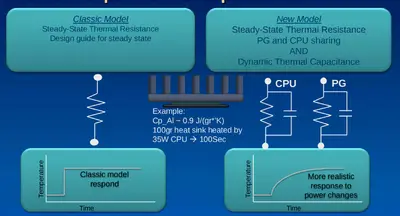| Line 15: | Line 15: | ||
:<math>\Psi_{\text{JA}} = \frac{T_\text{Junction} - T_A}{\text{TDP}}</math> | :<math>\Psi_{\text{JA}} = \frac{T_\text{Junction} - T_A}{\text{TDP}}</math> | ||
| + | |||
| + | == Thermal Capacitance == | ||
| + | [[File:sandy bridge dynamic thermal capacitance.png|right|400px]] | ||
| + | If an integrated circuit has been running at relatively cooler temperatures, the various materials such as the heatsink have also cooled. This mean that there is a small amount of time whereby it is possible for the IC to effectively exceed the rated amount of heat generated and have the heatsink quickly absorb this heat while still maintaining the rated TDP. Since {{intel|Sandy Bridge (Client)|Sandy Bridge|l=arch}}, Intel has switch to a dynamic thermal capacitance model which allows their chip to take advantage of this short amount of time at run hotter and at {{intel|turbo boost technology|higher frequency}} in order to extract additional performance. | ||
Revision as of 20:17, 30 March 2018
Thermal Design Power (TDP) is the amount of thermal power an integrated circuit generates under TCASE,MAX. A TDP of an IC represents that upper point of the thermal profile and is used for determining the appropriate thermal solution design target. TDP is a measure of heat and should not be confused with power dissipation which is a measure of the rate of work.
Overview
As an integrated circuit operates, some of the power applied is dissipated in the form of heat. This heat must consequently be removed from the die and out of the system in order to maintain operational temperature range. The ability to remove heat depends on the power dissipation, ambient temperature, and the thermal resistance of the materials used in the construction of the package.
Where the total thermal resistance (ψJunction-Ambient, ψJA) is the thermal resistance of the Junction to Sink (ψJS which also includes ψTIM) and the thermal resistance of the Sink to Ambient (ψSA). Note that this is measured in °C/W. ψSA is a function of the heatsink material, its thermal conductivity, and its geometry.
Therefore the maximum allowable resistance can be calculated as
Thermal Capacitance
If an integrated circuit has been running at relatively cooler temperatures, the various materials such as the heatsink have also cooled. This mean that there is a small amount of time whereby it is possible for the IC to effectively exceed the rated amount of heat generated and have the heatsink quickly absorb this heat while still maintaining the rated TDP. Since Sandy Bridge, Intel has switch to a dynamic thermal capacitance model which allows their chip to take advantage of this short amount of time at run hotter and at higher frequency in order to extract additional performance.

